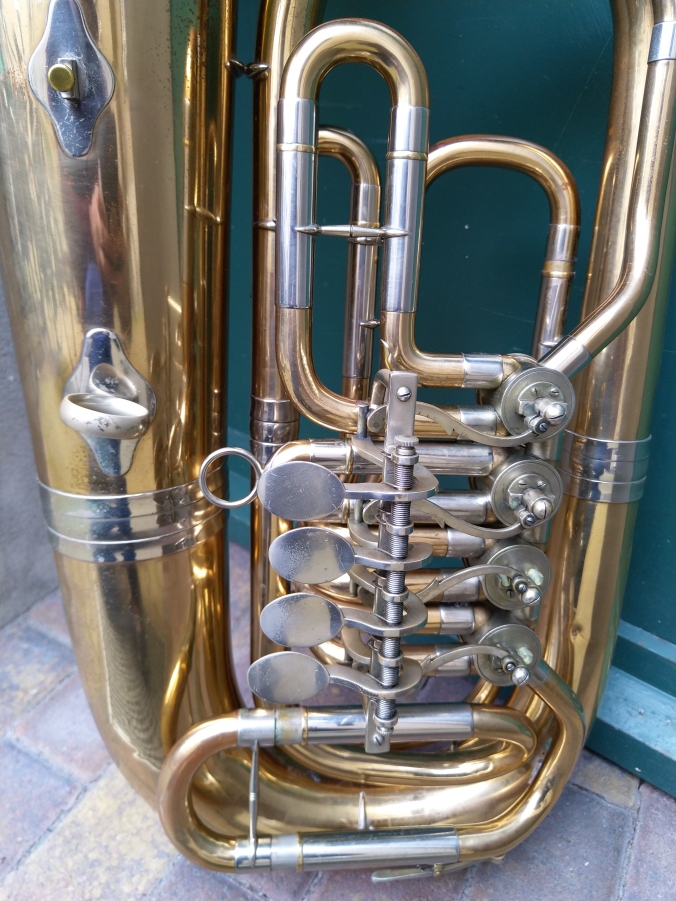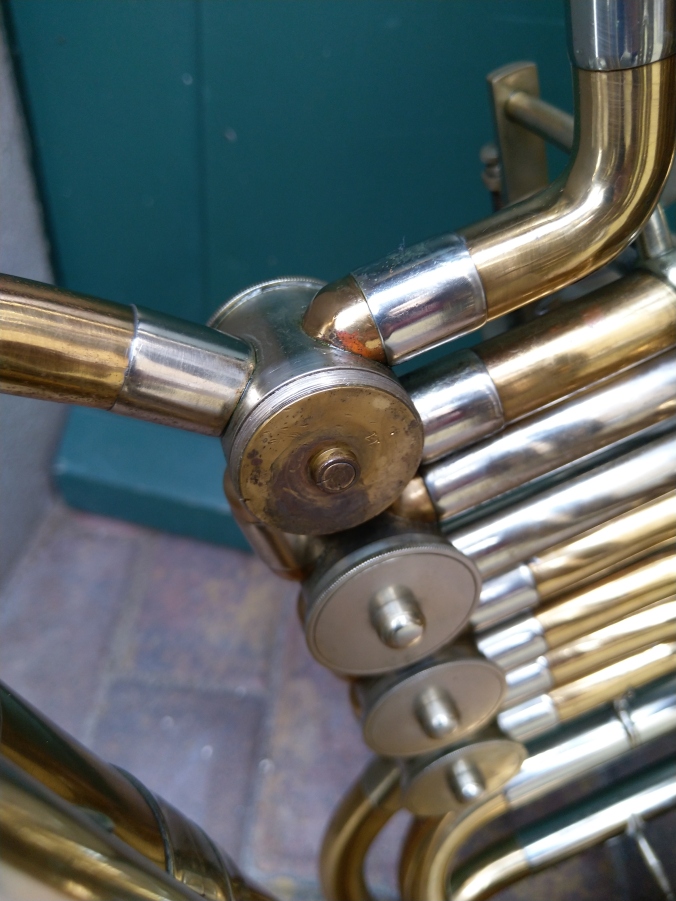
A well played, but much loved Eb tuba
Hello dear reader, at the moment, most of us are at home in self imposed quarantine. I can only hope all of you and your families are doing well. As I seem to have more free time in the upcoming weeks, I will take that as a chance to catch up on blog posts among other things.

driver’s view.
If you have followed this blog till now, you already know the history of how B&S came to be and perhaps a bit of the history behind their early models. Not to sound like a broken record, but for everyone else as the factory got its start in the early 1950s, they adopted several designs from the previous workshop, the factory Hess. Among those early models were a number of F and Eb (Es auf Deutsch) tubas all based off of a similar body design. If one would trace the history of these horns back far enough, they have similar roots to early 20th century Alexander F/Eb tubas, especially the model 154 etc. This was because in 1935, an instrument maker/engineer at Alexander moved to the factory Hess bringing many of their designs with him, and so on and so on.

Weltklang-one of the many export names for B&S
For some reason, not completely clear to me, B&S decided it needed another name for its export products and decided on “Weltklang”. I suppose in terms of trademarks that Weltklang (Sound of the World) was so vague as to not infringe on any other companies…if someone has more information on this, please let us know. B&S tubas could be ordered by any musicshop with their own engraving as well. For example in the USA, there were at least 15 different names that come up….

Compared to its cheaper versions, this Model 92 has generous amounts of nickelsilver.
There is a great deal of speculation whether Weltklang and B&S instruments differ, with some people saying Weltklang was the cheaper version and that it was built by less skilled workers using cheaper materials. Having spoken with former B&S workers who were there in the 1970s, here is what I can tell you.
1. The quality of work was identical regardless of whether it had B&S or Weltklang engraved on the bell. In fact, often until it was engraved, it could have been either or…What many people don’t realize, building tubas was and is not a great place to “learn”. A small mistake can ruin an entire instrument assembly therefore most apprentices spent some time in the highbrass department and under a very watchful eye before making their way to tubas and other low brass.
2. Some Weltklang instruments do have some money saving features. Often the valve casings were brass instead of nickelsilver. Also they will also have ferrels made from sheet nickelsilver rather than the 3D versions on the B&S. However there are B&S tubas with sheet ferrels and Weltklang tubas with 3D ferrels such as our featured tuba…so take what is on the bell with a grain of salt.

Ferrels in 3D nickelsilver, says Weltklang on the bell. Seems legit.
Our featured tuba was built in 1970 as a set of 6 instruments. It differs from the vast majority in that it has 4 valves, a body made of goldbrass and lots of nickelsilver trim, braces and valve casings. This is the only one I have ever seen till now in this format.
Most of them have yellow brass bodies with only 3 valves. It was ordered and sent to a military windband where it was used in a professional capacity until it was retired in 1990. Shortly before being decommissioned it was overhauled and lacquered and then found its way into loving hands where it has been put to good use ever since.

Leadpipe was cut to make dedenting easier…no cookie for you sir!
I would like to take a moment to reach out to my colleagues here. Sadly one often sees overhauled tubas where the leadpipe and 4th valve tubing were cut to facilitate access for dent removal. This is almost never necessary and it looks terrible, so please, stop doing this. I have never had to cut one and neither do you. In acoustically sensitive areas like a leadpipe, it makes even less sense.

And if you are going to cut, at least do it on the centerline so it’s less obvious.
In terms of playing characteristics, this is really quite a nice tuba. It has a very even response throughout its range and the intonation is excellent. The low range is great, especially the low Bb which jumps out faster than I would have imagined. The goldbrass body keeps the sound nice, even when you really step on it. If you were to compare to the various mass produced rotary Ebs available in the 70s such as the Miraphone 183 or the Cerveny 651, the Weltklang is far and away the superior instrument. Only when you compare to other 1970s higher end rotary Eb tubas like the Alexander 154, Rudolph Meinl Eb, or Hirsbrunner Eb then you start to be a bit more critical. The Alexander is a larger tuba and does put out more sound. The more modern Rudolph Meinl and Hirsbrunner both could be had with 5 valves and larger bores although adding a 5th valve to the Weltklang is not a difficult project. Considering the price difference, I still might take the Weltklang…

The receiver was shortened to bring up the pitch and to allow a standard mouthpiece shaft.
As the 1970s moved on, it became apparent that the older BBb/Eb/F tubas from B&S were becoming old fashioned and as such were redesigned. The basic conus was retained, but the various bows were rebent to reduce the overall height, moving away from the stovepipe look. The valve block was redesigned with 90 degree ports replacing 45 degree 1st and 4th valve porting. Many of the crooks were no longer bent by hand, rather in a ballout die. In addition, the bells were then made in two pieces, regardless of a kranz or not was fitted. While the manufacturing costs were reduced and the new versions looked more modern, some of the original character and “weight” in the sound was lost although the quality stayed. Sometimes newer is not always better…

Nickelsilver valve casing with 18mm valve cores.
Specs:
ca. 1970 Weltklang Eb Basstuba
Bell diameter 38cm
4 rotary valves 18mm bore
92cm high
7.20kg

sleepy tiger
Hey,
Great that you still post content about Eb tubas.
It’s hard to find information about them yet they are great instruments (at least some of them).
Have you ever encountered one of the B&F Amati Eb tubas with the 50cm bell?
Sometimes called Eb Kaiser-tuba?
May I ask if you know anything about them and how they compare to other Eb tubas from the same time like the Weltklang?
I’d love to know more about them.
Greetings,
Carlos
Thank you!
Yea I’ve seen the Amati Eb. Its quite large and while it has a big sound, the intonation seems to be an issue for this model.